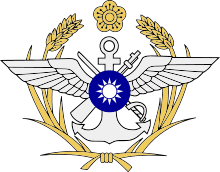Republic of China Air Force
The Republic of China Air Force (ROCAF; Chinese: 中華民國空軍; pinyin: Zhōnghuá Mínguó Kōngjūn,) is the military aviation branch of the Republic of China Armed Forces. The ROCAF's primary mission is the defense of the airspace over and around Taiwan. Priorities of the ROCAF include the development of long range reconnaissance and surveillance networks, integrating C4ISTAR systems to increase battle effectiveness, procuring counterstrike weapons, next generation fighters, and hardening airfields and other facilities to survive a surprise attack.
| Republic of China Air Force | |
|---|---|
| 中華民國空軍 Zhōnghuá Mínguó Kōngjūn (Mandarin) Chûng-fà Mìn-koet Khung-kiûn (Hakka) | |
_Logo.svg.png) Republic of China Air Force emblem | |
| Founded | 1920 |
| Country | |
| Size | ~600 aircraft |
| Part of | Ministry of National Defense |
| Commanders | |
| Commanding-General | Gen. Hsiung Hou-chi |
| Deputy Commanding-General | Lt. Gen. Chang Yen-ting Lt. Gen. Fan Ta-wei |
| HQs' Chief of Staff | Lt. Gen. Cheng Jung-feng |
| Insignia | |
| Roundel |   |
| Flag | 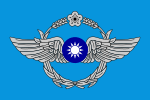 |
| Aircraft flown | |
| Electronic warfare | E-2T/K, C-130HE |
| Fighter | F-16A/B/C/D/V Block 20/70/72, Mirage-2000-5Di/Ei, F-CK-1A/B/C/D, F-5E/F |
| Helicopter | S-70C-1/1A, S-70C-6 |
| Reconnaissance | RF-5E, RF-16 |
| Trainer | AT-3B, T-34 |
| Transport | C-130H, Fokker 50, Beechcraft B-1900C, Boeing 737-800 |
| Republic of China Air Force | |||||||||||||||||
|---|---|---|---|---|---|---|---|---|---|---|---|---|---|---|---|---|---|
| Traditional Chinese | 中華民國空軍 | ||||||||||||||||
| Simplified Chinese | 中华民国空军 | ||||||||||||||||
| |||||||||||||||||
In May 2005, the Ministry of National Defense indicated its intention to transfer command of all defensive missile systems to the ROCAF, while future offensive missiles would be placed under a newly formed missile command. As of 2006, all medium and long range SAM units were transferred from ROC Army's Missile Command to ROCAF, while ROCAF's airbase security units were transferred to ROC Army Military Police. However, it was revealed that in January 2011, five years of problems of integrating those long range ex-ROC Army SAM units into ROCAF has forced ROCAF high command to return those units back to ROC Army's Missile Command. Missile Command is now directly under Defense Ministry's GHQ control.
In July 2010, former United States Air Force deputy under secretary for international affairs, Bruce Lemkin, said that Taiwan's ability to defend its airspace had degraded due to its ageing fighters and that the sale of new fighter aircraft to Taiwan was an urgent priority.[1] However, the ROC Air Force has trouble getting fighter planes from abroad due to mainland China's attempts to suppress fighter sales from any country. The People's Republic of China views the island of Taiwan as a rogue province instead of an independent nation, and has called the F-16 fighter or any foreign fighter sales a "red line." [2][3] It is believed that mainland China plans to eliminate the ROC Air Force by preventing the sales of new aircraft whilst gradually wearing its ageing fighters into an inoperable state as they have to frequently intercept PLAAF aircraft who perform almost daily approaches to ROC airspace.[4][5][6] According to the Republic of China's defense minister, Yen Teh-fa, the People's Republic of China sends about 2,000 bomber patrols per year to the Taiwan Strait separating Taiwan and China mainland.[7][8]
Organization
Like most of the other branches of the ROC armed forces, much of the ROCAF's structure and organization is patterned after the United States Air Force. Like the USAF, the ROCAF used to have a wing → group → squadron structure. After November 2004, tactical fighter wing switch to wing → Tactical Fighter Group, with some fighter squadrons stood down, with each tactical fighter group, still pretty much the same size as a squadron, now commanded by a full colonel.
Republic of China Air Force Command Headquarters
_General_Hsiung_Hou-chi_%E7%A9%BA%E8%BB%8D%E4%B8%8A%E5%B0%87%E7%86%8A%E5%8E%9A%E5%9F%BA_(20191129_%E7%A9%BA%E8%BB%8D%E5%8F%B8%E4%BB%A4).png)
- Air Force GHQ is subordinate to the Chief of the General Staff (military), the Minister of National Defense (civilian) and the President.
- Internal Units: Personnel, Combat Readiness and Training, Logistics, Planning, Communications, Electronics & Information, General Affairs, Comptroller, Inspector General, Political Warfare.
- Air Force Combatant Command
- Weather Wing: Tamsui, New Taipei City
- Communications, Air Traffic Control & Information Wing : Taipei City
- Air Tactical Control Wing
- Ground fixed and mobile long-range air search radar sites, consist of various TPS-117, TPS-75V, FPS-117, GE-592 and HADR radars, plus 1 PAVE PAWS (Phased Array Warning System) early warning radar site in northern Taiwan, will enter service late 2012.
- Air Defense Artillery Command
- 4 Air Defense Missile & Artillery brigades, 951st (Taipei), 952nd (Taichung), 953rd (Kaohsiung), 954th (Hualien)
- 4 Air Defense Missile I-HAWK battalions, 621st, 622nd, 662nd, and 664th battalions, with Phase III and 7 Phase I batteries.
- 1 TK-1/2 Air Defense Missile battalion, 951st Brigade, 611st battalion with 6 companies/batteries.
- 1 Patriot PAC-2+ GEM/PAC-3 Air Defense/Anti-Ballistic Missile battalion, with 3 mixed companies/batteries that are all upgrading to PAC-3 standard, with 7 more PAC 3 companies/batteries on order.
- 1 Skyguard Short Range Airbase Air Defense battalion, with 6 companies/batteries and radar sub units with OTO 35mm AAA, s
- 2 Antelope Short Range Airbase Air Defense battalions, with unknown companies/batteries.
- At least 2 AAA Air Defense Artillery battalions, with 40mm/L60 and 12.7mm AAA guns.
- Air Defense Artillery Training Center: Pingtung
- Target Service Squadron
- Education Service Support Company
- First training company
- Second training company
- Third training company
- Education, Training & Doctrine Command
History

Formally established in 1920 as the Aviation Ministry, the ROCAF was active during the tenure of the ROC on Mainland China. In this period, various airplanes were purchased and deployed by warlords in their struggle for power until nominal Chinese reunification in 1928. In February 1932, US Reserve Lt. Robert McCawley Short, who was transporting armed Chinese aircraft, shot down an IJN aircraft on February 19, 1932, and downed another on February 22 before he was killed (he was posthumously raised to the rank of colonel in the Chinese Air Service).
During the Second Sino-Japanese War (1937–1945), the ROCAF participated in attacks on Japanese warships on the eastern front and along the Yangtze river including support for the Battle of Shanghai in 1937. The Chinese frontline fighter aircraft initially were mainly the Curtiss Hawk II and III and the Boeing P-26 model 281, and engaged Japanese fighters in many major air battles beginning on August 14, 1937, when Imperial Japanese Navy warplanes raided Chienchiao airbase; "814" has thus become known as "Air Force Day". Chinese Boeing P-26/281 fighters engaged Japanese Mitsubishi A5M fighters in what is among the world's first aerial dogfighting between all-metal monoplane fighter aircraft. A unique mission in May 1938 saw two Chinese B-10 bombers fly a mission over Japan, but dropping only propaganda leaflets over the Japanese cities of Nagasaki and Saga, four years before 1942 Doolittle Raid on Japanese home islands. It was a war of attrition for the Chinese pilots, as many of their most experienced ace fighter pilots, such as Lieutenant Liu Tsui-Kang and Colonel Kao Chih-Hang were lost early in the war. Code breaking operations played a role in the conflict. A Japanese radio intercept unit was attached to the landing forces at Shanghai. IJN Lt. Commander Tsunezo Wachi and a Lt. Yamada, an expert in Chinese codes, enabled Japanese to make preemptive strikes against ROCAF airfields.[9]
In the latter half of the Sino-Japanese War, part of World War II, the ROCAF was augmented by a volunteer group of American pilots (the Flying Tigers) in 1941.[10] Throughout the war, the ROCAF was involved in attacks on Japanese air and ground forces in the Chinese theatre.
ROCAF General HQ was established in June 1946. From 1946 to 1948, during the Chinese Civil War, the ROCAF participated in combat against the People's Liberation Army engaging in air-to-air combat on at least eleven occasions in the areas surrounding the Taiwan Strait. The ROCAF reportedly enjoyed a 31:1 kill ratio against the PLA. GHQ was evacuated to Taiwan along with the rest of the ROC Government in April 1949 following the Communist victory in the Chinese Civil War.[11] The ROCAF assisted in halting the PLA advance at the Battle of Kuningtou on Kinmen the same year.
The ROCAF regularly patrolled the Taiwan Straits and fought many engagements with its Communist counterpart (the PLAAF). The ROCAF received second hand equipment from the US at that time, such as the F-86, F-100 and F-104.
During the Cold War, the ROCAF was involved in combat air patrols over the Taiwan Strait and engaged the PLAAF and PLAN-AF on several occasions. The ROCAF was also the testbed of American technology at this time. The first successful kill scored by an air-to-air missile was accomplished by a ROCAF F-86 Sabre with then experimental AIM-9 Sidewinder. ROCAF pilots also flew U-2 recon overflights of the PRC during this time with assistance from the USAF. Known as the Black Cat Squadron they flew a total of 220 missions, with 102 missions over mainland China, losing 5 aircraft. All five were shot down by SA-2 surface-to-air missiles, the same type of surface-to-air missile that shot down Gary Powers over the USSR in 1960. The 34th "Black Bat Squadron" flew low level missions into China as part of its mapping PRC growing air defense networks, conducting ESM and ECM missions, inserting agents behind enemy lines, and air drop resupply missions.
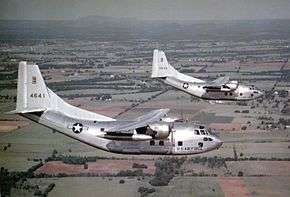
Starting in November 1967, the ROC secretly operated a cargo transport detachment to assist the US and the ROV as part of its participation in the Vietnam War. It was based on existing formation of the 34th squadron of ROC Air force. The unit's strength included two C-123 cargo aircraft, seven flight officers and two mechanics, even though a higher number of military personnel was involved through rotation. It was tasked with air transportation, airdrop and electronic reconnaissance.[12] Some 25 members of the unit were killed, among them 17 pilots and co-pilots, and three aircraft were lost. Other ROC involvement in Vietnam included a secret listening station, special reconnaissance and raiding squads, military advisers and civilian airline operations (which cost a further two aircraft due to Vietnamese individually operated AA missiles).[13]
From 1979 to 1990 the ROCAF engaged in a classified military aid program in Yemen Arab Republic known as the Great Desert Program (大漠計畫).[14] The program started after American President Jimmy Carter rushed 14 F-5s to the Yemeni Air Force who had no pilots or ground crew trained to operate the type or even western aircraft (they previously operated Mig-15s). The Americans and the Saudis (who were bankrolling the Yemen Arab Republic's military) requested military aid from Taiwan who provided 80 F-5 pilots, ground crews, early warning radars, and anti-aircraft missile batteries.[15] All told more than a thousand ROCAF personnel deployed to Yemen.[14]
The opposing Air Force of South Yemen was made up of Cuban Revolutionary Air and Air Defense Force pilots and maintainers with some Soviet advisors and pilots as well.[15] The ROCAF force were actively involved in combat with the Cubans/Soviets and for all intents and purposes constitutes the Yemen Arab Republic's Air Force during this time. Taiwanese pilots scored a number of kills and the air-defense and early warning radar teams took casualties from aerial attacks.[16] The program ended in 1990 when Saudi Arabia withdrew its diplomatic recognition of Taiwan.[14]
Humanitarian operations
The ROCAF has also taken part in numerous humanitarian operations. Some of the more major ones include the following:
- Indian Ocean earthquake and tsunami, December 2004[17][18]
- Haiti earthquake, January 2010[19][20]
- Typhoon Haiyan, November 2013[17][21]
Equipment and procurement
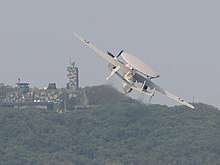
Current ROCAF inventory includes over 400 combat aircraft, the mainstays being the AIDC F-CK-1 Ching-kuo IDF (Indigenous Defense Fighter) and F-16 while the Mirage 2000-5 provides the most formidable air-defense capabilities. Older F-5 fighters are gradually being phased out but remain in service.
The United States serves as the ROCAF's main supplier of equipment and also provides training for ROCAF and ROC Navy pilots at Luke AFB in Arizona. This base which is between Phoenix and Tucson has an instrumented flight area for training approximately the size of the State of Connecticut. German Air Force (Luftwaffe) and German Naval Aviation (Marineflieger) who used to train at Luke AFB from 1957-1983 now train at NATO facilities at CFB Goose Bay in Canada and also alongside the USAF at Holloman AFB in New Mexico. As of 2019 the US Air Force is assisting the Taiwanese Air Force in sourcing new and surplus F-5 parts.[22]
Domestic development

Prior to 1984, ROCAF fighters were almost exclusively American-made aircraft sold under terms of a mutual defense treaty between the Republic of China and the United States. Development of the F-CK-1 Ching-kuo Indigenous Defense Fighter (IDF) began in 1984 due to U.S. refusal to sell F-16s to the ROCAF as a result of changes in national policy between the U.S. and the People's Republic of China. After a successful maiden flight in 1989, the domestically produced fighter entered service in 1994. However, the ROCAF was subsequently able to obtain F-16s from the United States as well as Mirage 2000-5 fighters from France, resulting in delays to later IDF development that had been anticipated.
In response to American refusals to supply "smart bombs", Taiwan is developing their own equivalent of the Joint Direct Attack Munition for attacks against the PRC mainland in case of invasion preparations.[23]
Taiwan is looking to replace its current fleet of AT-3 jet trainers and F-5 LIFT planes with 66 advanced trainers. In 2008 the Republic of China Air Force released a request for information (RFI) and two companies including Lockheed Martin for the T-50 and Alenia Aermacchi's M-346 responded to the request. These planes were expected to be license produced in Taiwan with a local partner firm, and the overall estimated contract value was 69 billion New Taiwan dollars (US$2.2 billion).[24] However, after the election of President Tsai Ing-wen, who intends to make Taiwan's defense industry a cornerstone for future development, it was decided to domestically design and build 66 AIDC T-5 Brave Eagle supersonic trainers instead of selecting the T-50 or M-346. The T-5, with a program cost of NT$68.6 billion, will be a new aircraft whose design will draw upon Taiwan's expertise gained by building the domestically produced Indigenous Defense Fighter.[25]
In 2019 the Taiwan Air Force's Air Defense and Missile Command announced a five-year, NT$80b (US$2.54b) project to build up a full force of anti-radiation UAVs made by NCSIST.[26]
Foreign procurement
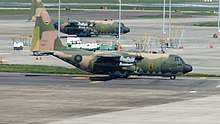
.jpg)
One of the first modern jets purchased was the Northrop F-5. In 1974 a total of 308 were purchased but, lacking spare parts, the ROC has been forced to salvage them from inoperable F-5s.[27] Taiwan is considering reusing engines from inoperable F-5s in cruise missiles.[28]
On February 28, 2007, the US Defense Department approved an order made by the ROC for 218 AIM-120C-7 AMRAAM missiles, as well as 235 AGM-65G2 Maverick missiles, associated launchers and other equipment. The total value of this order was revealed to be US$421 million.[29]
In June 2007, the Legislative Yuan also approved the upgrade of the existing PAC-2 batteries to PAC-3 standard, and, in November, the Pentagon notified the U.S. Congress of the Patriot upgrade order.[30] On August 10, 2007, a shipment of Harpoon anti-ship missiles, valued at an estimated $125 million, was also authorised by the U.S. Defense Department, including 60 AGM-84L Block II missiles and 50 upgrade kits to bring the ROCAF's existing Harpoons up to Block II, Mark L standard.[31]
On October 3, 2008, arms notifications were sent to Congress concerning, amongst other things, the sale of 330 PAC III missiles, 4 missile batteries, radar sets, ground stations and other equipment valued up to US$3.1 billion, the upgrade of 4 E-2T aircraft to the Hawkeye 2000 standard and US$334 million worth of spare parts for the ROCAF's F-16s, IDFs, F-5E/Fs and C-130s.[32] Late in January 2010, ROCAF received the first batch of new TC-2(V) BVR missiles ordered from CSIST, believed to have new radar seeker and improved performance from the original missile which entered service over 10 years ago.[33] The U.S. government also announced 5 notifications to Congress for additional arms sales totaling some US$6.39 Billion, under which the ROCAF will receive 3 PAC-3 batteries with 26 launchers and 114 PAC-3 missiles.[34] On February 3, 2010, ROCAF also announced at a Singapore Airshow that it had signed a new contract for 3 EC-225 SAR (Search-And-Rescue) helicopters that was awarded to Eurocopter back in December 2009 for US$111 million, along with options for 17 more EC-225s.[35][36] On November 26, 2011, the 3 EC-225 C-SAR helicopters were loaded on board an An-124 cargo aircraft and delivered to Chai-yi AB in Taiwan, and should enter service on July 1, 2012.[37]

On August 31, 2010, it was announced for next year's defense budget, ROCAF's "Medium Transport aircraft" plan to replace 12 B-1900 VIP/transport training aircraft, believed to be 6-8+ Lockheed C-27J, has been put on hold and might be axed, due to lack of budget, but will allocate 20+ million US dollars over next 4 years for quick runway repair.[38] Other items mentioned including increases in runways from 3 to 6 at Eastern Taiwan's 3 airbases, moving 2 I-HAWK batteries to Eastern Taiwan to protect those airbases, which will double to 4 batteries, and others.[39] On November 8, 2011, a second pair of E-2T Hawkeye AEW(s/n 2501 and 2502) were loaded on a ship and sent to the US for upgrade to the E-2C 2000 standard. The first pair of E-2T (s/n 2503 and 2504) were sent to the US in June 2010 and returned to Taiwan on December 18, 2011, and will be return to service by end of the year.[40][41]
On August 15, 2011, the United States again deferred the ROCAF request to purchase 66 new F-16C/Ds but offered a retrofit package for older F-16A/B's.[42] (originally 150 were brought in 1992)[43] However, the US allowed the F-16A/Bs to be upgraded to the AN/APG-83 radar.[44] Unfortunately, it was discovered the F-16A/Bs have rusting issues during the F-16V upgrade due to aging and Taiwan's climate.[45] The $5.3 billion upgrade package for ROCAF's existing F-16A/B fighters was announced on 21 September 2011.[39] The upgrade budget was to be spread over 12 years, though the Ministry of Defense indicated that it would try to reduce the period.[46] In November 2011, the United States-China Economic and Security Review Commission recommended that new fighters be sold to the ROCAF.[47] Taiwan is also balking at the cost of the radar upgrade, as it does not want to be the lead customer who pays to develop the upgrade and also because they will be unable to afford both the upgrade and the new fighters, should these be offered.[48] In response to a U.S. vote in the House of Representatives to force the sale of the C/D models, the ROC MND said that the upgrade package offered some superior capabilities over the C/D model aircraft and some defense officials have said that in light of the PRC's increasing capabilities, only the F-35 would be sufficient.[49]
In July 2012, Taiwan's Aerospace Industrial Development Corp. and Lockheed Martin announced plans to establish a maintenance and overhaul center to upgrade and maintain the F-16s in place without having to ship them back to the United States.[50] In 2012 a letter of acceptance was agreed on for a US$3.8 billion deal that included the radars, electronic warfare, structural improvements and new weapons.[51][52] A Pentagon report has corroborated that claim, asserting that the PRC would probably seek to destroy ROCAF airfields in the first stages of any attack, making a STOVL fighter such as the F-35B vital for effective defense.[53]

On April 10, 2019, Air Force Chief of Staff Liu Jen-yuan confirmed that the Air Force is asking for a total of new-built 66 F-16V fighter jets from the U.S. to replace its aging and nearly obsolete F-5 fighters.[54] Previous presidents after George H.W. Bush refused to sell F-16 fighters to the ROC Airforce, including George W. Bush in 2006 after a ROC request for F-16C/Ds.[55]
President Barack Obama also refused Taiwan's request for new F-16s in 2011. The Obama administration later allowed the ROC Airforce to upgrade its current F-16s though the upgrades did not start until 2017 and first upgraded aircraft were only delivered in 2018 during the Trump administration.[56][57][58]
On August 20, 2019, the sale of F-16 C/D Block 70, also known as F-16V, was officially approved by the State Department and formally submitted to Congress.[59] The 66 newly-built F-16s will be supplied with 75 General Electric F110 engines and 75 AN/APG-83 Scalable Agile Beam AESA radars.[60] The final signing of the Letter of Offer and Acceptance (LOA) for the purchase of 66 F-16V fighter jets was confirmed on December 21st, 2019. [61]
Rank and rating insignia
- Officers
| Equivalent NATO Code | OF-10 | OF-9 | OF-8 | OF-7 | OF-6 | OF-5 | OF-4 | OF-3 | OF-2 | OF-1 | OF(D) and student officer | |||||||||||||||||||||||||
|---|---|---|---|---|---|---|---|---|---|---|---|---|---|---|---|---|---|---|---|---|---|---|---|---|---|---|---|---|---|---|---|---|---|---|---|---|
(Edit) |
No equivalent |  |
 |
 |
 |
No equivalent |  |
 |
 |
 |
 |
 |
 | |||||||||||||||||||||||
| Full General 一級上將 Yījí Shàngjiàng |
General 二級上將 Èrjí Shàngjiàng |
Lieutenant General 中將 Zhōngjiàng |
Major General 少將 Shàojiàng |
Colonel 上校 Shàngxiào |
Lieutenant Colonel 中校 Zhōngxiào |
Major 少校 Shàoxiào |
Captain 上尉 Shàngwèi |
First Lieutenant 中尉 Zhōngwèi |
Second Lieutenant 少尉 Shàowèi |
Officer cadet 軍校生 Jūnxiào shēng | ||||||||||||||||||||||||||
- Enlisted
| Equivalent NATO Code | OR-9 | OR-8 | OR-7 | OR-6 | OR-5 | OR-4 | OR-3 | OR-2 | OR-1 | |||||||||||||||||||||||||||
|---|---|---|---|---|---|---|---|---|---|---|---|---|---|---|---|---|---|---|---|---|---|---|---|---|---|---|---|---|---|---|---|---|---|---|---|---|
(Edit) |
 |
 |
 |
 |
 |
 |
 |
 |
 | |||||||||||||||||||||||||||
| Master Sergeant First Class 一等士官長 Yīděng shìguānzhǎng |
Master Sergeant Second Class 二等士官長 Èrděng shìguānzhǎng |
Technical Sergeant 三等士官長 Sānděng shìguānzhǎng |
Staff Sergeant 上士 Shàngshì |
Sergeant 中士 Zhōngshì |
Corporal 下士 Xiàshì |
Specialist 上等兵 Shàngděngbīng |
Airman 一等兵 Yīděngbīng |
Airman Basic 二等兵 Èrděngbīng | ||||||||||||||||||||||||||||
Current inventory
.jpg)
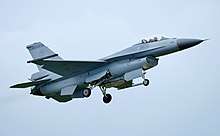
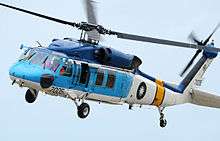
Armament



Air Defense
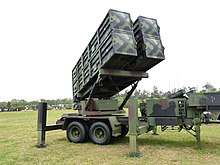
| Name | Origin | Type | In service | Notes | ||
|---|---|---|---|---|---|---|
| SAM | ||||||
| Patriot (PAC-2) | United States | SAM system | 7 | receiving upgrade to PAC-3.[76] 264 additional PAC-3 interceptors delivered in 2011, 122 PAC-3 interceptors delivered in 2015.[67] | ||
| Sky Bow | Republic Of China | SAM system | 6 | Sky Bow I replaced by the Sky Bow III missiles in 2015 | ||
| MIM-23 HAWK | United States | SAM system | 19[67] | |||
| Anti-aircraft artillery | ||||||
| Skyguard | Switzerland | towed anti-aircraft gun | 24 | twin gun, 35mm rounds | ||
| RIM-7 Sea Sparrow | United States | SAM system | 500 | used on towed launcher as part of the Skyguard System[77] | ||
| Sensors (independent of SAM batteries) | ||||||
| AN/FPS-117 | United States | Fixed Long-Range Radar System | 7[78] | Primary battlespace management radar[79] Acquired in 2002.[78] | ||
| AN/TPS-117 | United States | Mobile Long-Range Radar System | 4[78] | Acquired in 2002.[78] | ||
| PAVE PAWS | United States | Early warning radar system | 1 | |||
ROCAF Squadron emblems

"Black Bat". 34th Squadron 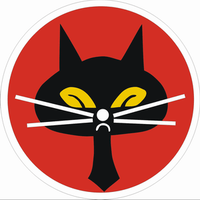
"Black Cat". 35th Squadron 
"Tiger Gazer". 12th Tactical Reconnaissance Squadron
See also
- Development of Chinese Nationalist air force (1937–45)
- Central Aircraft Manufacturing Company, also known as CAMCO
- Flying Tigers
- Black Bat Squadron
- Black Cat Squadron
- 21st Fighter Squadron
- Republic of China Air Force Academy
- Air Force Institute of Technology
- Republic of China Air Force Museum
- Ministry of National Defense (Republic of China)
- Republic of China Armed Forces
- People's Liberation Army Air Force
- Political status of Taiwan
References
- Reuters Editorial (5 July 2010). "INTERVIEW - Taiwan overdue for F-16 jets, ex U.S. official say". Reuters India. Archived from the original on 4 February 2016. Retrieved 30 January 2016.
- "Trump Is About To Challenge China's Red Line On Taiwan". Investor's Business Daily. March 22, 2019.
- "US threatening to cross red line of bilateral ties: China Daily editorial". China Daily. September 25, 2018.
- "China's Plan to Eliminate Taiwan's Air Force; How Beijing is Gradually Wearing Taipei's Ageing Fighters into Inoperability". Military Watch. June 20, 2018.
- "Will Taiwan Get the New F-16V Fighters It Desperately Wants?". The National Interest. July 20, 2019.
- "China's Greatest Wish: Is Taiwan's Air Force Dying?". The National Interest. April 24, 2018.
- "U.S. Voices concern over China's attempts to sway Taiwan election". Reuters. 2019-11-22.
- Grossman, Derek; Beauchamp-Mustafaga, Nathan; Ma, Logan; Chase, Michael S. (2018). China's Long-Range Bomber Flights: Drivers and Implications (PDF). Rand Corporation. ISBN 978-1-9774-0083-3.
- RADM. Layton USN, Edwin T.; Pineau, with Roger; Costello, John (1985). "And I was there" : Pearl Harbor and Midway--breaking the secrets (1st ed.). New York: W. Morrow. pp. 47. ISBN 0-688-04883-8.
- Rossi, J.R. "History: The Flying Tigers - American Volunteer Group - Chinese Air Force". Archived from the original on 2013-07-22. Retrieved 2012-06-07.
- "Taiwan in Time: The great retreat - Taipei Times". www.taipeitimes.com. Archived from the original on 2018-07-30. Retrieved 2018-07-31.
- TREVITHICK, JOSEPH (2016-12-03). "America and Taiwan Had a Secret Transport Squadron in Vietnam". medium.com. Medium. Retrieved 21 July 2019.
- Lin, Hsiao-ting (2016-04-07). "Taiwan's Cold War in Southeast Asia". /www.wilsoncenter.org. The Wilson Center. Retrieved 21 July 2019.
- Jonathan Chin, Lo Tien-pin and. "Air force highlights secret North Yemen operations". www.taipeitimes.com. Taipei Times. Retrieved 21 July 2019.
- Hoagl, Jim (May 28, 1979). "Taiwanese Hired By North Yemen To Fly U.S. Jets". The Washington Post. The Washington Post. Retrieved 21 July 2019.
- "Northrop F-5E/F in Service with Taiwan". www.joebaugher.com. joebaugher.com. Retrieved 21 July 2019.
- "Taiwan C-130 aircraft deliver relief supplies to the Philippines". AsiaOne. Archived from the original on 20 February 2016. Retrieved 30 January 2016.
- Humanitarian response to the 2004 Indian Ocean earthquake
- "Air Force C-130 returns after delivering supplies to Haiti". Archived from the original on 2015-05-01. Retrieved 2014-09-23.
- "Haiti earthquake: News updates". cnn.com. Archived from the original on 4 March 2016. Retrieved 30 January 2016.
- "Planes fly relief supplies to Philippines". taipeitimes.com. Archived from the original on 3 February 2016. Retrieved 30 January 2016.
- Jennings, Gareth. "US seeks to restart parts manufacture for Taiwan F-5s". janes.com. Janes. Retrieved 27 May 2019.
- "Taiwan develops 'smart' munitions against China: report". www.defensenews.com. Agence France-Presse. 21 September 2013. Retrieved 24 September 2013.
- "空軍高級教練機轉自製 美、義爭與台廠合作拚690億商機-風傳媒". 2015-07-20. Archived from the original on 2017-12-29. Retrieved 2019-04-05.
- "'Blue Magpie' program to be inked today". Archived from the original on 2018-07-27. Retrieved 2019-04-05.
- Liao, George. "Taiwan military to spend NT$80 billion on anti-radiation drone fleet". www.taiwannews.com.tw. Taiwan News. Retrieved 22 June 2019.
- "The US Air Force wants to assess sources that can provide spare parts for Taiwan's fleet of Northrop F-5E fighters". FlightGlobal. May 2, 2019.
- "Taiwan is Reverse-Engineering Fighter Jet Engines to Power a Cruise Missile". Popular Mechanics. January 3, 2019.
- "US missile deal to boost Taiwan defense". The Standard. 2007-03-02. Archived from the original on 2007-09-26. Retrieved 2007-07-08.
- "Taipei Economic and Cultural Representative Office in the United States - PATRIOT Configuration 2 Ground Systems Upgrade" (PDF). Defense News. 2007-11-09. Archived from the original (PDF) on 2007-11-28. Retrieved 2007-11-13.
- "US Congress notified of possible sale of missiles". Taipei Times. 2007-08-10. Archived from the original on 2007-09-29. Retrieved 2007-08-21.
- "Taiwan supporters laud weapons sale". Taipei Times. 2008. Archived from the original on 2008-10-06. Retrieved 2009-06-20.
- "ROCAF showing newly received TC-2 missiles". The Liberty Times. 2020. Archived from the original on 2010-01-30. Retrieved 2010-01-28.
- "USDA New Release" (PDF). dsca.mil. 2010-01-29. Archived from the original (PDF) on 2011-07-21. Retrieved 2010-01-29.
- Branigan, Tania (2010-02-05). "Taiwanese military orders German helicopters". London: The Guardian newspaper. Archived from the original on 2013-09-09. Retrieved 2010-02-25.
- "Eurocopter Sale to Taiwan - Contract Detail Document". taiwanmilitary.org. 2010-02-06. Archived from the original on 2011-07-18. Retrieved 2010-02-25.
- "EC-225 C-SAR Helo, New Military Search And Rescue Power". news.sina.com.tw. 2011-11-26. Retrieved 2011-11-26.
- "Next Year Defense Budget Believed To Be Lowest In 5 Years". United Daily newspaper. 2010-08-31. Archived from the original on 2010-08-31. Retrieved 2010-09-12.
- "Defending Against Second Wave Missile Attack, Quickly Fix Runways, Camouflages With Decoys". China Times. 2010-08-31. Archived from the original on 2010-09-09. Retrieved 2010-09-12.
- "ROCAF AEW Aircraft Loaded On Ship This Morning To Send To US For Upgrades". China Times. 2011-11-08. Retrieved 2011-11-08.
- "ROCAF AEW Hawkeye 3 project ADW Aircraft Returned, Performances Vastly Upgraded". Military News Agency. 2011-12-18. Archived from the original on 2012-07-08. Retrieved 2011-12-18.
- "Taipei Economic and Cultural Representative Office in the United States - Retrofit of F-16A/B Aircraft" (PDF). DSCA. 2011-09-21. Archived from the original (PDF) on 2011-10-27. Retrieved 2011-09-23.
- "Bush Announces Sale Of F-16 Aircraft To Taiwan, 1992". USC US-China Institute. September 2, 1992.
- "F-16V Radar Integration Clears Way For Taiwan Upgrade". IHS Jane's Defence. Archived from the original on 2014-10-23. Retrieved 2014-12-15.
- "Rust Problem Causes Delivery Delays for Taiwan's F-16V Jets". Defense-Aerospace. December 12, 2018.
- Liu, Nancy. "F-16 A/B upgrade budget to be spread over 12 years: MND." Archived 2011-09-26 at the Wayback Machine ROC Central News Agency, 22 September 2011.
- Weisgerber, Marcus. "U.S. Report Recommends New Fighters for Taiwan." Defense News, 16 November 2011.
- Minnick, Wendell. "Taiwan Might Delay F-16 Upgrade." Defense News, May 5, 2012.
- Hou, Elaine. "F-35 fighters best suit Taiwan's air defense needs: official." CNA, 29 May 2012.
- "Taiwan, U.S. companies ink MOU on F-16 upgrades." Archived 2015-06-20 at the Wayback Machine ROC Central News Agency, 12 July 2012.
- Hou, Elaine. "Taiwan signs F-16 A/Bs upgrade deal with U.S." Archived 2015-06-20 at the Wayback Machine ROC Central News Agency, 16 July 2012.
- "Taiwan unlikely to acquire F-35 fighters soon: U.S. business council." Archived 2015-06-20 at the Wayback Machine ROC Central News Agency, 19 July 2012.
- Tkacik, John J. Jr. "TKACIK: White House bickering and Taiwan's F-16s." Archived 2011-09-23 at the Wayback Machine Wash. Times, 20 September 2011.
- "U.S. to decide whether to grant Taiwan F-16V sale in July: MND". Focus Taiwan. April 10, 2019.
- "Taiwan's Plan to Buy F16C/D Suspended by U.S. President". Defense Aerospace. October 2, 2006.
- "No New F-16's for Taiwan, but U.S. to Upgrade Fleet". The New York Times. September 18, 2011.
- "Taiwan takes delivery of first locally upgraded F-16". Defense News. October 22, 2018.
- "Taiwan Receives First F-16V Upgrade". Ainonline. October 23, 2018.
- "Trump admin formally approves fighter jet sale to Taiwan amid China trade fight". CNN. August 20, 2019.
- "Taipei Economic and Cultural Representative Office in the United States (TECRO) – F-16C/D Block 70 Aircraft and Related Equipment and Support". Defense Security Cooperation Agency. August 20, 2019.
- "Taiwan and U.S. Sign agreement for F-16V fighter jet deal".
- "World Air Forces 2020". Flightglobal Insight. 2020. Retrieved 10 February 2020.
- Corporation, TWAIDC-Aerospace Industrial Development. "TWAIDC - Aerospace Industrial Development Corporation". TWAIDC - Aerospace Industrial Development Corporation.
- Sands, Glenn (2015). "FORCE REPORT: Rep. of China Air Force pg. 53". Key Publishing. Missing or empty
|url=(help) - Yeo, Mike (November 26, 2018). "Taiwan takes delivery of first locally upgraded F-16". Defense News.
- "Taiwan takes delivery of 200 AIM-120 AMRAAM missiles". Archived from the original on 2018-07-24. Retrieved 2018-07-24.
- Trade Registers Archived 2010-04-14 at the Wayback Machine. Armstrade.sipri.org. Retrieved on 2015-04-10
- "TC-1 Air-to-Air Missile System". ncsist.org.tw. Chungshan Institute of Science and Technology. Archived from the original on 27 October 2018. Retrieved 6 April 2019.
- Lo Tien-pin, Jonathan Chin. "Extended-range missiles ready for use". taipeitimes.com. Taipei Times. Archived from the original on 1 April 2019. Retrieved 6 April 2019.
- "Wan Chien". csis.org. Center for Strategic and International studies. Archived from the original on 6 April 2019. Retrieved 6 April 2019.
- Ralph, Jennings (2018-08-18). "Taiwan steps up production of missiles to create asymmetric advantage over China military build-up". nationalpost.com. Associated Press. Retrieved 6 May 2019.
- Chaunren, Chen. "Taiwan's Ching-kuo Upgrade Complete, SEAD Role Next". ainonline.com. The Convention News Company, inc. Retrieved 20 April 2019.
- DeAeth, Duncan. "US arms company Raytheon takes new contract for Taiwan missile upgrades". taiwannews.com. Taiwan News. Retrieved 28 May 2019.
- "Hsiung Feng II". csis.org. Center for Strategic and International Studies. Archived from the original on 2 April 2019. Retrieved 2 April 2019.
- "TRADE REGISTERS". sipri.org. Stockholm International Peace Research Institute. Retrieved 19 April 2019.
- "First Upgraded PAC-3 Battery Is Based At Nang Kang". Liberty Times. 2012-04-04. Archived from the original on 2012-04-03. Retrieved 2012-04-04.
- "Hundreds of missiles placed 'on hold' as Taiwan awaits US". Archived from the original on 2018-10-06. Retrieved 2018-10-06.
- "Taiwan To Receive Early-Warning Radars From US: Jane's". www.spacedaily.com. Space Daily. AFP. Retrieved 25 January 2020.
- Zhezheng, Hong. "The Air Force admits that the Army's war management radars cannot detect early warning drone threats". udn.com. United Daily News. Retrieved 25 January 2020.
External links
| Wikimedia Commons has media related to Air force of the Republic of China. |
| Wikisource has original text related to this article: |
- ROCAF website
- ROC active aircraft (in English)
